So, you’ve made the decision to take up lure fishing for pike? This guide aims to assist you in making informed choices and saving a few quid along the way!
Embarking on the world of lure fishing can be overwhelming, to say the least. Nowadays, there are numerous options when it comes to lures, tactics, and methods, making it difficult to know where to begin. Well, fear not! Let’s start at the beginning and dive into the fishing tackle you’ll need.
Please note: While we only ever link to tackle and lures that we have used and recommended, some of the links on this page are affiliate links. This means that if you click a link and buy the product we may receive a small commission from the retailer (at no cost to yourself). Should you choose to use an affiliate link please know that we are extremely grateful and any money we receive helps us to maintain the blog and continue our adventure.
Looking for the best pike lures? Check out our guide here
Pike lure fishing tackle
Fishing Rod
Most readers of this guide will likely have used a standard fixed spool rod and reel combination before, and in my opinion, this is the optimal choice for beginners in pike fishing with lures. More experienced lure anglers may opt for a baitcaster rod and reel. Baitcasters are typically favored for their enhanced casting distance, but they can be a bit challenging to handle and often result in more time spent untangling lines than catching fish! My advice is to stick with what you know, unless you have prior experience with a baitcaster.
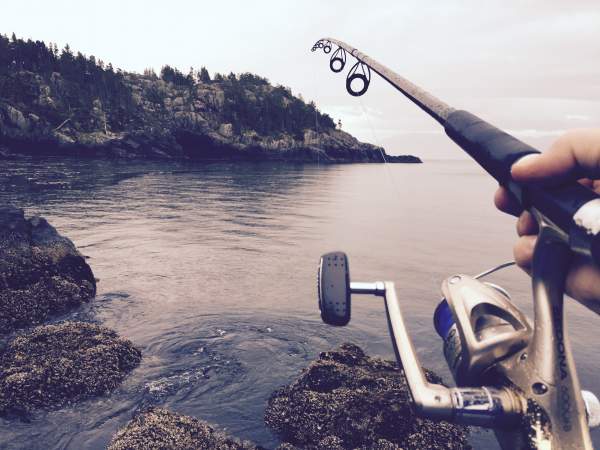
The fishing rods you’ll be considering are specialist lure rods, also known as spinning rods. These rods share similar performance characteristics, offering ample power from the middle section to the butt, coupled with soft tip sections. They are typically shorter in length, ranging between 6ft and 10ft, and come in various power ratings. The power of a lure rod is indicated by its casting weight, which you can find marked on the rod’s blank. These figures, such as 5-25g, 15-40g, or 30-60g, represent the weight of lures that the rod can cast. Consequently, the higher the weight, the more powerful the rod will be.
Why not check out the best jerk rod setup in our guide
For beginners venturing into the world of lure fishing for pike, an excellent starting point would be an 8ft rod with a casting weight of approximately 15-40g. This combination provides ample power to cast a wide range of general-purpose lures while also offering the necessary strength to control and handle larger pike, should you be fortunate enough to hook one.
When selecting a rod, it’s advisable to look for good value rather than settling for a bargain-basement option. Aim for a decent mid-range rod that strikes the right balance. While it’s best to avoid the higher-end models in the early stages, as you gain more experience, you can consider upgrading to a higher quality rod.
Examples of the rods you could go for are:
Spinning Reel
Certainly! Here’s an improved version of the content, optimized for the keyword “lure fishing for pike” and using British spelling:
As mentioned earlier, if you’re new to lure fishing, it’s advisable to steer clear of baitcaster reels. These reels can be challenging to set up correctly and often lead to complications during casting. For newcomers, it’s best to stick with the more user-friendly and familiar fixed spool reels. They offer a simpler setup and casting process, allowing you to focus on honing your lure fishing skills without the added complexities.
We explored the best spinning reels under £100 in the blog
By far the best choice would be a small fixed spool reel in the 4000 sizes. A compact front drag model is ideal as they are small and lightweight, but a rear drag reel will definitely suffice.
The reels below would be a great place to start:
Line
Most anglers will be familiar with ‘mono’ line but when it comes to lure fishing, Braid is the way to go. This ultra-thin material is perfect because unlike mono it has no stretch. This allows the angler to work the lure, making it jerk quickly, flick over, rise up and dive down rapidly.
When it comes to lure fishing, most anglers are familiar with traditional monofilament (“mono”) line. However, for optimal performance, braid is the way to go. This ultra-thin material offers several advantages over mono. Firstly, braid has virtually no stretch, allowing the angler to manipulate the lure with precision. You can jerk it quickly, flick it over, make it rise up, and dive down rapidly. Moreover, the lack of stretch provides superior bite detection, as braid allows you to feel even the slightest plucks on the lure. It has a unique ability to communicate indications from the lure to the tip of the rod.
The best fishing tv shows – Get your fix now
In addition, braid is significantly thinner than mono of the same weight rating. For instance, a 30lb braid will be much thinner than a 30lb mono line. This thinness translates to increased casting distance when using braid. It allows you to cast your lures further, reaching those enticing spots. However, remember that the quality of your line is essential. Opt for a reputable brand to ensure reliability and durability.
Wire Trace
Pike are equipped with ultra-sharp teeth, so it’s important to exercise caution and protect your fingers! To guard against the risk of a “bite off,” always use a wire trace when lure fishing for pike. This trace securely attaches to your braid and the lure itself. While there has been an ongoing debate about whether to use a wire trace or a fluorocarbon trace, it’s crucial not to be swayed by arguments against using a wire trace. The wire trace serves two vital purposes: preventing the loss of lures and, more importantly, avoiding the unfortunate scenario of leaving a lure inside a pike’s mouth, which could potentially harm or kill the fish. Rest assured, using a wire trace will not hinder your ability to catch fish. I personally use one consistently and have successfully caught numerous pike, both large and small.
For an ideal lure fishing wire trace, look for flexibility and a length of approximately 10 inches. It should have a breaking strain of 20-30lb and feature a swivel at one end and a snap link at the other. The snap link allows for quick and easy lure changes, adding convenience to your fishing experience.
Lure Fishing for Pike – The Essentials
Before we dive into discussing lures, let’s cover a few essential pieces of fish care equipment that are crucial for your success in lure fishing for pike.
First and foremost, a landing net is essential. This will allow you to safely and efficiently land your catches without causing harm to the fish or risking losing them. Look for a net with a wide opening and a fish-friendly mesh material.
Additionally, a good pair of unhooking pliers or forceps is indispensable. These tools will enable you to remove hooks from a pike’s mouth quickly and safely, minimizing any potential harm to the fish and ensuring your own safety as well.
It’s also important to have a suitable-sized and accurate weighing scale. This will allow you to measure and record the weight of your catches, adding to the excitement and providing valuable data for your angling endeavors.
Lastly, carrying a quality fish-friendly unhooking mat is highly recommended. This will provide a safe and comfortable surface for handling the pike, reducing stress and potential injury to the fish during the unhooking process.
By having these essential fish care tools, you’ll be well-prepared to ensure the well-being of the pike you catch while enjoying your lure fishing adventures.
Forceps
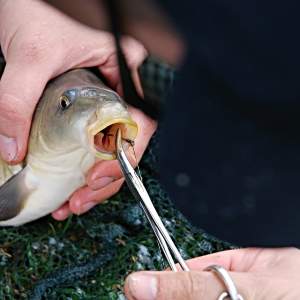
A must-have item for any predator angler is a set of long-nosed forceps. Pike’s razor-sharp teeth can easily cut your hand if you’re not careful, so these forceps are essential for safe hook removal. Generally measuring around 12 inches long, they are perfect for reaching deep into a pike’s mouth or through its gill plates to remove hooks that may be buried in the jaw or mouth.
By using long-nosed forceps, you can ensure the safety of both yourself and the pike while effectively and carefully removing hooks. These forceps provide the necessary reach and precision to handle the situation without causing harm to the fish.
Wire cutters
Another essential item of kit that you should have is a sturdy pair of wire cutters. These cutters will prove invaluable in situations where you may need to cut a wire trace. They come in handy when dealing with pike that are hooked awkwardly or when a set of treble hooks becomes entangled in your landing net, requiring you to cut the wire to free them.
Having a reliable pair of wire cutters ensures that you’re prepared to handle such scenarios effectively and safely. It allows you to swiftly and cleanly cut through the wire, resolving any entanglements without causing unnecessary harm to yourself or the fish.
Large landing net
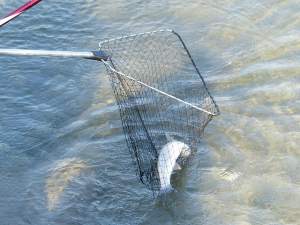
To safely handle and raise a large pike from the water, it’s essential to invest in a large triangular landing net. Look for a net with a robust 6ft handle and folding 36-inch arms, as this size will be adequate for holding specimen pike securely. Ensuring you have a net with the appropriate dimensions will greatly assist in safely landing and handling the fish during the catch-and-release process.
In addition to a suitable landing net, don’t forget to bring along your unhooking mat. This fish-friendly mat provides a cushioned and protective surface for the pike while you remove hooks or perform other necessary tasks. It helps minimize stress and potential injury to the fish, allowing for a safer and more responsible angling experience.
First aid kit
Even the most experienced pike angler may encounter cuts and grazes, particularly during the process of unhooking and landing the fish. It’s important to be prepared by carrying a few essential items to treat any wounds that may occur.
Firstly, having a supply of plasters (band-aids) is highly recommended. These can help cover and protect small cuts and abrasions, promoting faster healing and preventing further contamination.
Additionally, carrying antiseptic hand wipes is a wise precaution. They allow you to clean your hands thoroughly before and after handling the pike, minimizing the risk of infection and ensuring good hygiene practices.
Lastly, having a few tissues on hand can be helpful for various purposes, such as wiping away blood or excess moisture, providing temporary padding, or even as makeshift bandages in case of more substantial injuries.
By having these basic first aid items readily available, you can promptly attend to any minor wounds and ensure proper care and hygiene while enjoying your pike fishing adventures.
The fun bit – Lures
Undoubtedly, one of the major attractions of lure fishing is the opportunity to try out various lures. However, it’s important to exercise caution, as lures can be quite expensive. The good news is that you don’t need to purchase hundreds of lures to catch fish effectively. It’s essential to be mindful of the lure bug, the temptation to accumulate an excessive number of lures without practical necessity.
Before investing in your selection of pike fishing lures, there are a few considerations to keep in mind. Let me outline them for you below:
1. Research and understand the local pike fishing conditions: Knowing the specific characteristics of the waters you’ll be fishing in can help you choose lures that are most effective for those conditions. Consider factors like water clarity, depth, and the presence of vegetation or structure.
2. Assess the pike’s feeding habits: Understanding the primary prey of pike in your fishing area can guide your lure selection. Matching your lures to mimic the natural forage of pike can greatly increase your chances of success.
3. Start with versatile and proven lure types: Begin with a selection of lures that are known to be effective for pike fishing. This might include jerkbaits, spinnerbaits, soft plastic swimbaits, or crankbaits. These versatile lures cover a range of presentations and can be adapted to different fishing scenarios.
4. Gradually expand your collection: Instead of buying numerous lures all at once, consider gradually expanding your collection based on your experiences and specific fishing needs. This approach allows you to learn the strengths and weaknesses of different lure types and make informed decisions on future purchases.By carefully considering these factors and adopting a mindful approach to lure selection, you can make strategic choices that enhance your pike fishing experience without unnecessary expenses.
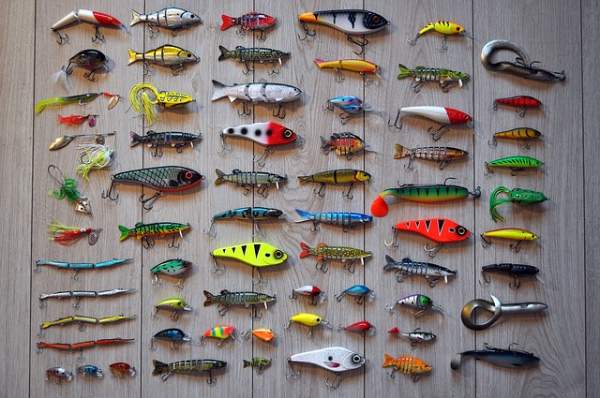
Depth
Knowing the waters you’ll be fishing in and selecting a variety of lures that cover different depths is indeed a crucial consideration when choosing your lures for pike fishing. This ensures that you have the appropriate lures to effectively target pike at various depths within the water column.
By understanding the depths of the fishing area, you can tailor your lure selection accordingly. Different types of lures, such as shallow-running crankbaits, deep-diving crankbaits, or weighted swimbaits, are designed to operate at specific depths. By having a range of lures that cover different depth ranges, you increase your chances of presenting the lure at the right level where the pike are likely to be feeding.
Additionally, considering the water conditions, such as clarity and vegetation, can further guide your lure selection. Lures that are suitable for clear water or weedless presentations can be advantageous in certain environments.
By having a well-rounded selection of lures that cover different depths and suit the specific conditions of the fishing area, you’ll be well-prepared to effectively target pike at various locations within the water column.
Interested in the wonderful world of custom lure building? Our interview with the founder of bully baits will be right up your street. Read now
Colour
While lure colour may not be the sole determining factor, having a variety of lure colours can be beneficial as it allows you to adapt to what entices a pike on a particular day. There are a few factors that I personally consider when selecting lure colours. Let’s explore them below:
1. Water visibility: The clarity of the water plays a role in lure colour selection. In clear water, opting for natural colours that closely resemble the prevalent prey species, such as Roach or Perch, can be effective (“match the hatch” principle). These natural colours blend in with the surroundings and appear more realistic to the pike.
2. Water conditions: In dirty or murky water, where visibility is limited, using brighter and more visible lure colours can be advantageous. Colours like Fire Tiger, which feature vibrant combinations of orange, yellow, and black, can stand out and attract pike in such conditions.
3. Light conditions: Consider the lighting conditions when choosing lure colours. Even in dirty water, if the sunlight is bright, it can enhance the visibility of your lure. In such cases, reverting to natural colours can be a sensible choice, as they provide a more realistic appearance.By taking into account water visibility, conditions, and light levels, you can make informed decisions regarding lure colours. Having a selection of both natural and vibrant colours in your tackle box allows you to experiment and adjust based on the specific fishing circumstances
Action
In clear water conditions, it’s advantageous to choose lures with subtle actions and natural colours. Lures that mimic the movement of prey species found in the area can be highly effective. Opt for lures with lifelike swimming actions and colours that closely resemble the local baitfish, such as Roach or Perch. Metallic spoons can also be effective, as their flash can attract the attention of pike in clear water. Taking advantage of favourable light conditions, such as bright sunlight, can further enhance the visibility and appeal of these lures.
Lure fishing for pike on rivers can provide some serious fun – See our guide
Conversely, in dirty or murky water, pike rely more on their instincts and sensory perceptions to locate prey. In these conditions, selecting lures with erratic actions and those that create noise can be highly effective. Erratic actions can simulate injured or struggling prey, triggering the predatory response of pike. Additionally, lures with built-in rattles or those that produce vibrations can help pike locate the bait through their lateral line sensory system. The Fire Tiger pattern, with its bright and contrasting colours, can be an excellent choice to grab the attention of pike in these conditions.
By considering the water clarity, light conditions, and the types of actions and visual cues that are most likely to trigger pike’s predatory instincts, you can select a range of lures that cater to different situations and maximize your chances of success.
Size
Matching the size of your lure to your tackle is crucial, but it’s also important to use common sense and consider the available prey fish. To increase your chances of success, it’s advisable to select a lure size that matches the size of the prey fish in the area. However, don’t hesitate to experiment and adjust your lure size based on the specific fishing situation.
Using larger lures can be effective when targeting big fish. If you know that larger pike are present and you want to specifically target them, using the maximum size lure that your tackle can handle is a sensible approach. These larger lures can imitate the larger prey fish that big pike often feed on, increasing your chances of enticing them to strike.
However, if you’re not getting any bites or if the situation calls for it, don’t hesitate to scale down your lure size. This can be particularly useful when targeting smaller pike or when the fishing conditions are challenging. Scaling down to smaller lures allows you to present a more realistic and less intimidating offering, increasing the likelihood of enticing bites from smaller Jack Pike or in situations where the fish may be more wary.
By considering the available prey fish, the presence of larger pike, and adjusting your lure size accordingly, you can optimize your chances of success during your pike fishing expeditions.
Types of Lure
Jerkbaits
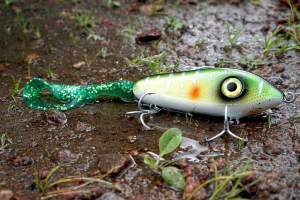
Jerkbaits can be highly effective, especially during the hotter months of the year. Their erratic action and wobbling motion are known to trigger pike into striking. Jerkbaits are similar in shape to plugs, but they require the angler to provide the action rather than having a built-in one.
By imparting downward jerks with the rod, you can bring the jerkbait to life, mimicking the movements of an injured or fleeing prey fish. This action can be highly enticing to pike, triggering their predatory instincts and enticing them to strike. Jerkbaits are available in both floating and sinking variations, providing options for different fishing scenarios and depths.
Many anglers find using jerkbaits to be the most exciting and challenging aspect of lure fishing for pike. It requires skill and technique to master the proper jerking motion and cadence to make the lure behave in a lifelike manner. The thrill of seeing a pike react to your actions and strike the jerkbait adds to the overall excitement of the fishing experience.
Later, we’ll delve into more details about floating, sinking, and suspending lures, which will further enhance your understanding and selection of lures for pike fishing.
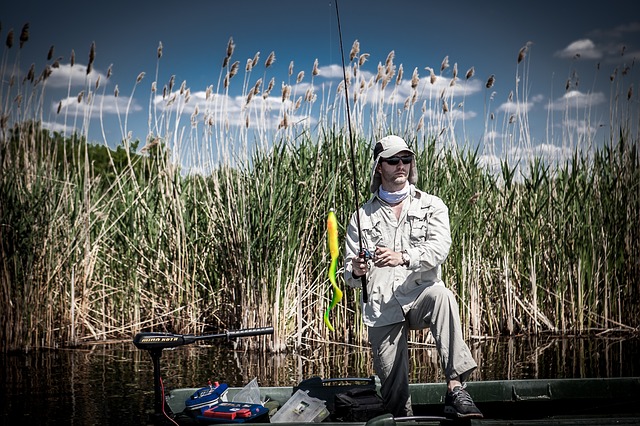
Soft Plastics
Soft plastic lures have revolutionised the world of fishing in recent years, offering anglers a wide range of shapes and sizes to choose from. These lures have become popular due to their versatility and unique advantages. There are two key benefits of using soft plastics for pike fishing.
Firstly, the soft bodies and tails of these lures allow for a variety of retrieves. Whether it’s a slow and steady retrieve, a sink and draw technique, or jigging motions, soft plastics can be worked at different speeds and actions to imitate wounded or fleeing prey. Their flexibility and lifelike movement in the water make them highly effective in enticing pike strikes.
Secondly, soft plastics sink, which opens up another dimension of fishing possibilities. By using the count-down method, you can control the depth at which the lure is presented to the pike. The longer you let the soft plastic sink, the deeper it will go. This versatility allows you to target fish at different depths and adjust your strategy based on the location and behavior of the pike.
Soft plastics offer a tremendous amount of flexibility and can be adapted to various fishing techniques and conditions. Their ability to be fished slowly and their sink rate make them a valuable addition to any angler’s lure collection when targeting pike.
Spoons
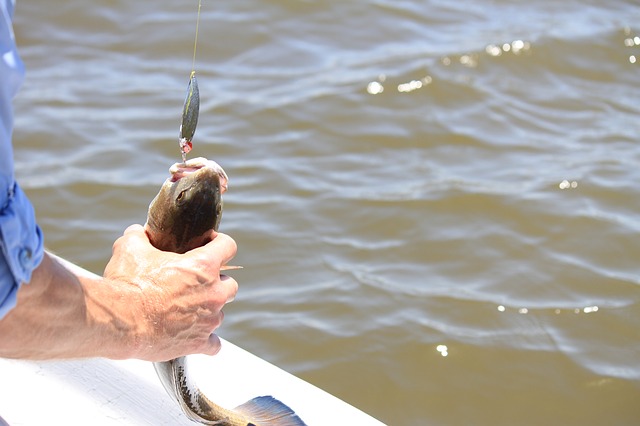
When it comes to lure fishing for pike, one type of lure that should not be overlooked is the trusty spoon. Pike fishing spoons are versatile and effective lures that can entice strikes from these predatory fish. Here are some tips to optimize your pike fishing experience using spoons:
- Choose the right spoon: Pike fishing spoons come in various sizes, shapes, and colours. Larger spoons in the range of 3 to 5 inches are often favoured as they mimic the size of the baitfish that pike feed on. Opt for spoons with a wide wobbling action and a reflective, fish-attracting finish.
- Consider water conditions: When fishing with spoons, it’s important to take into account the water clarity and light conditions. In clear water, opt for spoons with a more natural colour pattern such as silver, gold, or chrome. In murky or stained water, go for brighter colours like chartreuse, orange, or red to enhance visibility and trigger aggressive strikes.
- Vary your retrieval speed: Experiment with different retrieval speeds to find what triggers the pike’s feeding response. Start with a medium retrieve and then mix it up by speeding up, slowing down, or incorporating pauses in your retrieval. This erratic action can mimic injured or fleeing baitfish, enticing pike to strike.
- Target structure and cover: Pike are ambush predators and tend to hide around structures like weed beds, fallen trees, or rock formations. Cast your spoon near these areas and work it through the edges and openings to provoke strikes. Be prepared for sudden strikes as pike often attack spoons aggressively.
- Use a wire trace: As pike have sharp teeth, it’s essential to use a wire trace when fishing with spoons. This prevents bite-offs and ensures you don’t lose your lure to a toothy encounter. Attach the spoon to the wire trace using a reliable snap link or swivel for easy lure changes.
- Stay adaptable: Pike behaviour can vary depending on factors such as weather, water temperature, and time of day. Be observant and willing to adapt your spoon presentation and techniques accordingly. If one retrieve style or spoon colour is not yielding results, try different approaches until you find what works.
Remember to always prioritise safety and handle pike with care. Use appropriate landing nets and unhooking mats to protect the fish and yourself during the catch-and-release process. Check local fishing regulations and obtain any necessary permits before heading out to ensure you are fishing legally and responsibly.
By following these tips and incorporating pike fishing spoons into your arsenal, you increase your chances of enticing strikes from these formidable fish and enjoying a successful day on the water.
Spinners
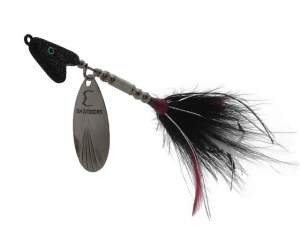
Spinners are renowned for their simplicity and effectiveness in attracting a variety of fish, including predatory species. They offer an easy-to-use option for anglers and are a valuable addition when fishing for pike with lures. Spinners utilize vibration and motion to grab the attention of fish, making them particularly effective in murky or dirty water conditions.
One notable spinner variation is the Offset Spinnerbait, which holds the advantage of being nearly weedless. This feature makes it an excellent choice when fishing in areas with dense vegetation or underwater structures where snags are common. The versatility of the Offset Spinnerbait allows for fishing at various speeds and depths, accommodating different fishing situations and preferences.
I highly recommend anglers, regardless of their experience level, to include a selection of spinners in their lure box. Their simplicity, effectiveness, and ability to target a wide range of fish, including pike, make them a valuable asset in any angler’s tackle arsenal.
Sinking, Floating or Suspending Lures?
Topwater lures
When it comes to lure fishing for pike, you have the option of using sinking, floating, or suspending lures, each with its own characteristics and advantages. Let’s start with topwater lures.
Topwater lures are designed to float on the surface of the water column. They are specifically designed to imitate wounded or vulnerable baitfish, as well as other creatures like birds, frogs, or rats. These lures create disturbances and commotion on the water’s surface, often referred to as “poppers,” which can attract predators like pike.
Using topwater lures can provide an exhilarating experience, as you witness pike striking the lure on the surface. The sight of a pike chasing and aggressively attacking a topwater lure can be truly heart-pounding. It’s important to note that topwater lures, such as poppers, tend to work best in warmer weather when the pike are more active and likely to respond to surface action.
Including topwater lures in your arsenal can be a thrilling way to target pike and add an extra level of excitement to your fishing adventures. However, it’s important to consider the prevailing weather conditions and the activity level of the fish when deciding which type of lure to use.
Suspending Lures
Suspending lures are highly effective when it comes to imitating stunned or injured baitfish, making them a great choice for targeting pike. These lures have the unique ability to suspend in the water once you stop retrieving them, adding a realistic element to their presentation.
When using suspending lures, it’s recommended to experiment with different retrieval speeds, alternating between fast and slow retrieves, and incorporating pauses to entice strikes from the pike. This technique can mimic the erratic behavior of injured prey, triggering the predatory instincts of the pike.
Various types of lures work well in a suspending configuration, including jerkbaits, crankbaits, and soft plastics. These lures offer versatility and can be effective throughout the year, making them suitable for all seasons. Whether you’re fishing in colder or warmer conditions, suspending lures can entice strikes from pike and increase your chances of success.
Including a selection of suspending lures in your tackle box allows you to adapt to different fishing situations and capitalize on the pike’s predatory behavior. By mastering the technique of using suspending lures, you can enhance your lure fishing experience and increase your chances of landing a pike.
Diving Lures
Diving lures offer another effective approach for lure fishing for pike. These lures are designed to dive underwater when retrieved, and their diving depth is influenced by the speed of your retrieval. The faster you retrieve the lure, the deeper it will dive.
Diving lures may come with or without a lip, also known as a diving vane. The lip helps control the lure’s depth and swimming action. To target specific depths, you can use diving lures to “count down” by allowing the lure to sink to the desired depth before starting your retrieval. This technique allows you to effectively reach deeper areas where pike may be lurking.
By adjusting your retrieval speed and incorporating pauses or jerks in your technique, you can create an enticing swimming action that mimics the movements of prey fish. Experimenting with different speeds, depths, and action variations can help you trigger strikes from pike.
Including a variety of diving lures in your tackle box gives you the flexibility to adapt to different water depths and conditions. Whether you need to reach the bottom quickly or explore different layers of the water column, diving lures can be a valuable tool in your pursuit of pike.
Floating Lures
Floating lures are highly versatile and effective for lure fishing for pike. These lures are designed to sit on the surface of the water and can be retrieved to a specific depth before they rise back up. This characteristic makes them ideal for working over weed beds, submerged structures, and other features where pike often hide.
When using floating lures, you can adjust your retrieval speed and technique to control the depth at which the lure swims. By cranking the lure down to a desired depth and then pausing or changing your retrieval speed, you can create enticing movements that attract the attention of pike.
Floating lures are particularly useful for targeting pike in areas with dense vegetation or obstacles. Their buoyancy allows them to navigate over weed beds and avoid getting tangled, increasing your chances of a successful retrieve.
To maximize the effectiveness of floating lures, consider experimenting with different retrieval speeds, pauses, and variations in your technique. This can simulate the erratic movements of injured or distressed prey, triggering the predatory instincts of pike.
Including a selection of floating lures in your tackle box provides you with options to effectively fish various water conditions and structures. By mastering the use of floating lures, you can enhance your lure fishing experience and increase your chances of enticing strikes from pike.
Lure Fishing Techniques
Understanding the various techniques used in lure fishing for pike is crucial for success. It’s important to keep in mind that different techniques may yield varying results on different days. Pike can be unpredictable, so it’s advantageous to have multiple techniques in your arsenal.
One key consideration is determining where and at what depth you should fish your lures. This can be influenced by factors such as the time of year, water temperature, and the presence of features like weeds and changes in depth. During this time of year, after the pike have spawned and are seeking nourishment and energy, they are often found in the shallows. Using shallow swimming and surface lures at different speeds can be effective in attracting strikes.
In addition to regular retrieves, incorporating erratic retrieves like twitching and jerking can be productive. These erratic movements imitate injured or distressed prey, triggering the pike’s predatory instincts and enticing them to strike.
Experimentation is key when it comes to lure fishing techniques. If a particular technique doesn’t yield results, don’t hesitate to switch things up and try a different approach. Pay attention to the pike’s behavior and adapt your techniques accordingly.
Remember, pike can be cunning and selective, so it’s important to be patient and persistent. By having a repertoire of techniques and adapting to the conditions and behavior of the fish, you increase your chances of success in lure fishing for pike.
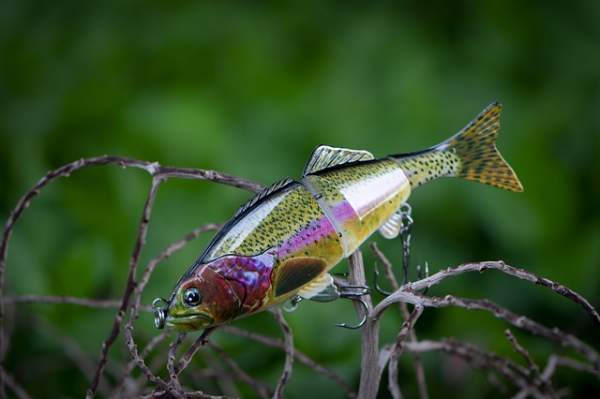
Your first consideration should be where and at what depth should you be fishing your lures? This is determined by time of year, the temperature of the water, location of features such as weeds and changes in depth.
Lure Fishing in Spring
During the spring season, it is common to find pike in the shallows as they have recently spawned and are actively seeking food to replenish their energy levels. This presents an excellent opportunity for lure fishing. Shallow swimming and surface lures are effective choices during this time. By using these lures and varying your retrieval speed, you can entice strikes from hungry pike.
To make your presentation even more enticing, incorporating erratic retrieves such as twitching and jerking can mimic the movements of injured or distressed prey. These erratic actions can trigger the predatory instincts of pike, making them more likely to strike your lure.
Keep in mind that while these general guidelines can be a good starting point, the behavior of pike can vary depending on the specific location and prevailing conditions. It’s important to observe the behavior of the fish and adjust your techniques accordingly. Additionally, trying out different lures and experimenting with various retrieves can help you determine what works best on a given day.
Always remember to follow local fishing regulations and practice catch-and-release whenever possible to help maintain healthy fish populations. Enjoy the thrill of lure fishing for pike in the springtime, and good luck on your angling adventures!
Lure Fishing in Summer
Lure fishing in the summer can be an exciting and productive time for targeting pike. As the water temperatures rise, pike become more active and aggressive in their feeding behavior. Here are some tips for successful lure fishing during the summer months:
1. Target structure and cover: Look for areas with submerged vegetation, weed beds, fallen trees, and rocky structures. These provide hiding spots and ambush points for pike. Casting your lures near these structures can attract strikes.
2. Use a variety of lures: Summer allows for a wide range of lure options. Topwater lures, such as poppers or buzzbaits, can be effective early in the morning or late in the evening when pike are more likely to be near the surface. Crankbaits, jerkbaits, and soft plastics are versatile choices that can imitate injured baitfish and trigger pike strikes.
3. Vary your retrieval speed: Experiment with different retrieval speeds to find what piques the interest of pike. Sometimes a slow and steady retrieve can be effective, while other times a faster retrieve with occasional pauses or erratic movements can trigger strikes.
4. Fish during low-light periods: In the summer, pike may be more active during low-light conditions such as early morning, late evening, or on cloudy days. Take advantage of these times when pike are more likely to be actively feeding and searching for prey.
5. Consider deeper water: As the summer progresses and water temperatures rise, pike may seek deeper water to find cooler and more comfortable conditions. Targeting drop-offs, submerged points, and deeper structures can yield good results.Remember to always prioritize the safety and well-being of the fish. Use appropriate tackle and ensure proper handling techniques when landing and releasing pike. Additionally, be mindful of local fishing regulations and practice responsible angling.
Enjoy the thrill of summer lure fishing for pike, and adapt your techniques based on the specific conditions and behaviors you encounter on the water.
Lure Fishing in Autumn
Lure fishing for pike in autumn is an exciting endeavor as these predatory fish gear up for winter. They become more active and aggressively feed, making it a prime time for anglers to target them. Here are some tips to optimize your lure fishing experience for pike in autumn, with a focus on British spelling and the use of pike fishing spoons:
- Target feeding areas: Pike tend to gather in areas where baitfish are abundant during autumn. Look for weed beds, drop-offs, and spots with structure where baitfish shoal up. These are prime hunting grounds for pike.
- Employ fast and erratic retrieves: Pike in autumn are often more responsive to fast and irregular lure movements. Experiment with varying retrieval speeds, jerking motions, and pauses to trigger their predatory instincts. Sinking jerkbaits, spinnerbaits, spoons, and deep-bodied plugs are excellent choices to imitate injured or fleeing baitfish.
- Adjust lure presentation: Pike may display preferences for specific lure colors or sizes during this season, so it’s important to be adaptable. Natural colors such as silver, white, and chartreuse can be effective, as well as brighter hues to enhance visibility in stained water.
- Consider water temperature: As autumn progresses, water temperatures drop, influencing pike behavior. Keep an eye on temperature changes and adjust your tactics accordingly. If pike are holding at deeper depths, try using sinking jerkbaits or weighted lures to reach them effectively.
- Stay versatile: Pike behavior can vary depending on local conditions and individual fish. Stay observant and be ready to adapt your techniques and lure choices throughout your fishing session. Pay attention to feedback from the fish and make adjustments accordingly.
Pike fishing spoons, known for their enticing wobbling action, are particularly effective in autumn. Their flash and vibration mimic injured baitfish, making them irresistible to hungry pike. Experiment with different sizes, colors, and retrieval speeds to find the optimal combination that entices pike strikes.
Always ensure you are familiar with and adhere to local fishing regulations and obtain any required permits before embarking on your pike fishing adventure. Enjoy the thrill of lure fishing for pike in autumn and have a successful angling experience!
Lure Fishing in Winter
Lure fishing for pike in winter requires a different approach due to the colder water temperatures and the pike’s decreased activity levels. Here are some tips to maximize your success during the winter months:
- Opt for sinking baits: In winter, pike tend to be less willing to chase down fast-moving lures. Sinking baits, such as jigging spoons or soft plastics rigged with a weighted hook, are excellent choices. These lures will sink to the bottom where pike are likely to be holding and can be worked effectively in a vertical jigging motion.
- Slow down your retrieve: Pike in winter are typically less active and more lethargic. It’s crucial to slow down your retrieve and give the fish ample time to react to your lure. Use a slow and steady retrieval speed, allowing the lure to remain in the strike zone for longer periods.
- Target deeper water: As water temperatures drop, pike often seek out deeper areas where the temperature is more stable. Focus your efforts on deeper sections of the waterbody, such as channels, drop-offs, and submerged structures. These areas provide the pike with a comfortable environment and potential feeding opportunities.
- Fish close to the bottom: During winter, pike tend to hug the bottom of the water column. Bump your sinking bait along the bottom, imitating a wounded or sluggish prey fish. Maintain contact with the bottom, but be mindful of snags or excessive drag that may hinder your presentation.
- Choose natural and subtle colors: In the colder and clearer water of winter, pike can be more cautious and selective in their feeding. Opt for lures with natural and subtle color patterns that mimic the appearance of local baitfish. Silver, white, and perch-like colors are often effective choices.
- Stay patient and persistent: Winter can be a challenging time for pike fishing, with fewer bites and slower action. It’s essential to remain patient and persistent. Be prepared to spend more time in each location, thoroughly working the area before moving on. Pay attention to subtle bites or changes in line tension, as pike may take the bait more gently during this time.
- Dress appropriately: Fishing in winter requires proper clothing to stay warm and comfortable. Layer up with thermal clothing, wear waterproof and insulated gear, and don’t forget gloves and a hat to protect yourself from the cold.
Remember to prioritize the welfare of the fish by handling them with care and practicing catch-and-release whenever possible. Ensure you are familiar with local fishing regulations and obtain any necessary permits before fishing.
Although winter may present challenges, employing these tactics and adjusting your approach can increase your chances of success when lure fishing for pike during the colder months. Stay persistent, adapt to the conditions, and enjoy the thrill of landing winter pike.
Countdown Method
I mentioned this technique a couple of times when explaining the different types of lure. The Countdown Method can be used with all styles of sinking baits such as jerkbaits, spoons and soft plastics. It is effective at searching different layers of water. Cast your bait and count how long it takes to hit bottom. Use this as your guide to vary the depths you retrieve your lure. Eventually, you will find the fish. When you do find them it pays to hang around a bit as pike are usually found in groups.
Unhooking a Pike
Unhooking pike can be a tricky job. It’s always best to be shown by someone who is experienced at lure fishing for pike or pike fishing in general.
Your forceps we talked about earlier are perfect for the job. A pikes mouth is huge and 8-inch forceps might not even reach so have a decent set of 10″ long nose pliers with you just in case.
Remember to use your unhooking mat especially when you are dealing with a fish on anything other than grass. For more help on unhooking you should give this video a watch.
Let’s go fishing!
Absolutely! Learning to fish with lures is an exciting journey, and it’s essential to maintain a positive attitude even if your initial trips don’t yield the desired results. Fishing is a learning process, and each outing provides an opportunity to improve your techniques and gain valuable experience.
Take the time to become familiar with your fishing gear, including your rods, reels, lines, and lures. Practice casting and retrieving techniques to develop accuracy and consistency in your presentations. Experiment with different retrieve speeds, pauses, and lure actions to understand what works best in different conditions.
Getting to know the water you’re fishing is crucial for success. Study maps, research online, or talk to local anglers to gather information about the lake, river, or fishing spot you’ll be visiting. Learn about the pike’s preferred habitats, such as weed beds, submerged structures, or drop-offs. Understanding the water’s characteristics will help you pinpoint areas where pike are likely to be found.
Additionally, observe the behavior of the fish and pay attention to any signs of activity, such as surface disturbances, feeding activity, or baitfish movements. Being attuned to these details will give you valuable insights and increase your chances of locating and catching pike.
Remember, fishing is a blend of skill, knowledge, and patience. Keep practicing, adapt your techniques as needed, and don’t be afraid to try new approaches. Celebrate each small success and learn from any setbacks. With time and experience, you’ll become more proficient in lure fishing for pike and increase your chances of landing those prized catches. Enjoy the journey and the excitement that comes with exploring the world of lure fishing!
If I can help or there is something you would like to see a post on just comment below or contact us. I hope this post has been helpful. All the best and welcome to lure fishing! If you enjoyed this post why not check out lure fishing for perch
Let us know below if this post helped you to catch fish!

Pingback: The Best Perch Lures In 2019 (UK) | Pike & Zander
Pingback: Jika Rig - Catch More Perch | Pike & Zander | Top UK Lure Fishing Blog
Pingback: KODEX Karp-Lokker KL40 Carryall Review | Pike & Zander
Pingback: Best Pike Lures 2019 | Pike & Zander | UK Lure Fishing Blog
Love this, very comprehensive guide to lure fishing for pike . Alot of the same principles will apply to Perch, Zander and even bass. Keep up the good work.
Cheers
Kyle
Pingback: Lure Fishing Techniques | Pike & Zander | Predator Angling Blog
Pingback: Fishing for Pike with Lures | A Complete Guide
Pingback: Pike Unhooking Tools | Pike & Zander | Lure Fishing Blog
Pingback: FishSpy Echo Pro Review - The Best Castable Sonar You Can Buy
Pingback: The 3 Golden Rules of Lure Fishing by Andy Hewitt - Andy Hewitt - Top Specimen Angler
Really enjoyed this fishing article. I’ve bookmarked your site for future reading. Keep up the good work!
Finally, information that I can really follow! Thank you so much.
Pingback: Best Spinning Reels Under £100 (2020) | Pike & Zander | Predator Angling Blog
Pingback: Plug Fishing - A Complete Guide | Pikezander | Predator Angling Blog
Pingback: Deeper Chirp+ Review 2021 | Pikezander | Outstanding Castable Sonar